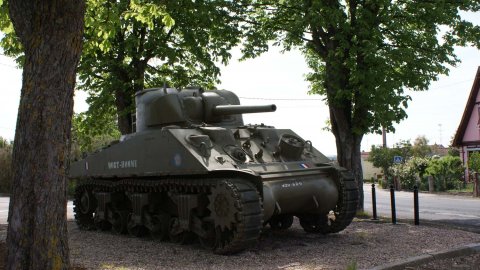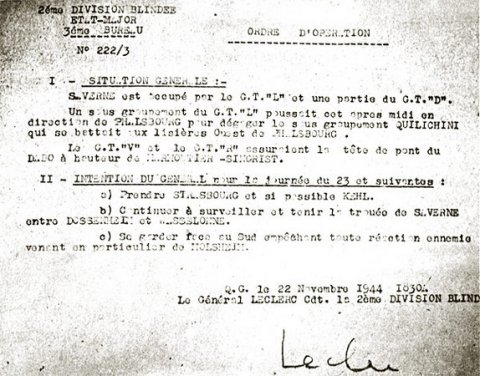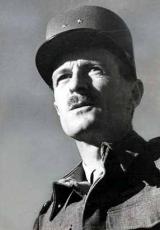The liberation of Strasbourg
Sous-titre
November 1944 – January 1945

After rounding out its forces by incorporating FFI fighters, the 2nd Armoured Division, as part of the American 15th Army Corps (3rd and then 7th US Armies), were given the objective of taking Epinal. Starting on 12 September, a detachment from the division worked in liaison with elements of the 1st Motorised Infantry Division (former DFL). Leclerc pushed through to Vittel, Contrexéville and Dompaire. Baccarat was liberated on 30 October with the help of resistance fighters. Badonviller was liberated on 17 November.

The Mort-Homme Sherman tank of the 2nd Armoured Division, transformed into a memorial monument at the very spot where it was put out of action on 17 November 1944, in Badonviller. Source: GNU Free Documentation License
Leclerc prepared to cross the Vosges Mountains across the Saverne Pass to reach the Alsace Plain and Strasbourg. American General Haislip authorised Leclerc to push through to Strasbourg and to try to take Kehl Bridge intact. On 22 November, General Leclerc gave the order to take Strasbourg and, if possible, Kehl, on the other side of the Rhine, while continuing to monitor and hold the Saverne Pass and to keep an eye on the enemy reactions to the south.

Operation order from General Leclerc (22 Nov. 1944). Photo © Strasbourg Archives
The Guillebon group had to push to the south of Strasbourg, while the Langlade group, notably including the 12th Chasseurs d’Afrique regiment, had to take the north side of the city. The Dio group was to continue clearing out the Saverne Pass and ensure the flank guard to the north of the division. On 23 November, at 6.45 am, the groups started out. At 10 am, the first elements of the Rouvillois group commanding the 12th cuirassier regiment entered the Alsatian capital. At the start of the afternoon, the Massu sub-group did the same.

A Fusiliers Marins patrol looking for sharpshooters on the roofs. Photo © Strasbourg Archives
In a proclamation, Leclerc reminded the people of Strasbourg that liberating the capital of Alsace had been his obsession for three years. The liberation of Strasbourg was doubly symbolic. It fulfilled the Oath of Kufra, and it liberated the capital of Alsace, which had been annexed by the 3rd Reich.

Soldiers of the 2nd Armoured Division with young Alsatian women. Photo © Strasbourg Archives
But Leclerc was unable to take advantage of the situation to the south, where de Lattre had liberated Mulhouse. Furthermore, the Germans wanted to defend what they considered as part of the Reich’s territory at all costs. They prepared a counterattack that was supposed to push the Allies far away from the German border. On 16 December, they launched a vast offensive in the Ardennes. The Americans were caught off guard. On 31 December, a new phase of the German offensive was launched in Alsace, between Bitche and Saverne. On 5 January, Strasbourg was threatened by a German bridgehead at Gambsheim. General de Gaulle managed to convince the Americans to let the 3rd Algerian Division defend the city while American troops retreated to the Haguenau-Wingen line. On 9 January, the 10th Infantry Division, made up of FFI fighters, came to reinforce the forces.
Between the Ill River and the Rhine-Rhone canal, the German attack that began on 7 January pushed back the 1st Motorised Infantry Division, which suffered heavy losses. To the north, German tanks forced the Americans to pull back over the Moder, but on 22 January, an energetic intervention by the 2nd Armoured Division (under the orders of the 1st French Army) managed to stabilise the front some fifteen kilometres from the Alsatian capital, which nonetheless remained threatened by the Germans.

Meeting of French and American soldiers at Rouffach on 5 February 1945, after closing the Colmar Pocket. Source: U.S. National Archives and Records Administration
At the beginning of February 1945, to take the pressure off Strasbourg and northern Alsace, General de Lattre de Tassigny decided to resume his offensive against Colmar and its pocket of German defences.


